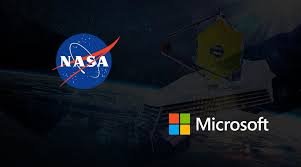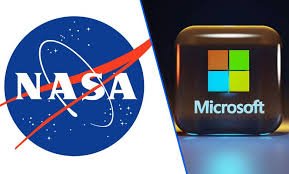NASA Partners with Microsoft to Simplify Access to Earth Science Data
Introduction
NASA has announced a groundbreaking partnership with Microsoft to streamline and enhance the accessibility of Earth science data for researchers, educators, and the general public. The collaboration aims to utilize Microsoft’s cloud computing capabilities and artificial intelligence tools to make vast datasets collected by NASA’s Earth-observing satellites more accessible and user-friendly.
This partnership is part of NASA’s broader initiative to democratize data usage, allowing a wider range of people, from students to professionals, to gain insights into the Earth’s environment. Through Microsoft’s Azure cloud platform, this data will be stored, processed, and made available for global use, significantly improving how researchers analyze and act on environmental changes.
Key Features of the Partnership
NASA’s Earth-observing satellites generate petabytes of data related to climate change, air quality, deforestation, natural disasters, and more. The partnership will leverage Microsoft’s Azure cloud to store, manage, and analyze this data. Additionally, Microsoft’s AI tools will help process the data faster, providing insights in real-time.
Through this collaboration, the data will be accessible to a broader audience, including policymakers, scientists, and local communities. The initiative also promises to enhance educational resources, offering students and educators access to critical Earth science data to foster learning and innovation.
Enhanced Accessibility for Earth Science Data
One of the main objectives of this partnership is to simplify how Earth science data is accessed and used. By moving NASA’s data to the cloud, the information will be more easily accessible, cutting down on the time and complexity involved in processing large datasets. This innovation will also facilitate new research and allow data from various Earth-observing missions to be combined for more comprehensive insights.

Why This News is Important
Making Earth Science Data Accessible
NASA’s partnership with Microsoft is transforming how Earth science data is made available to the public and researchers worldwide. This collaboration will enable the easier sharing and processing of critical environmental data, which can be used to monitor climate change, natural disasters, and biodiversity loss. The accessibility of this data is crucial for enhancing scientific understanding and informing global environmental policies.
Fostering Scientific and Technological Advancements
With the integration of Microsoft’s advanced AI and cloud computing tools, the partnership will expedite the processing of large datasets. This will facilitate quicker research and more accurate predictions, significantly improving how scientists study and address global challenges such as climate change and deforestation.
Impact on Education
For students, this news highlights the importance of data science, AI, and cloud computing in today’s world. The ability to use real-world data for educational purposes will not only enhance learning but also open up career pathways in the tech and environmental sectors. It emphasizes the growing importance of technology in scientific research and education.
Supporting Policy and Decision-Making
This partnership provides policymakers with the tools they need to make informed decisions regarding environmental issues. By having access to accurate and timely data, they can design more effective policies aimed at combating climate change and protecting natural resources. This development is particularly significant for students pursuing careers in environmental policy, governance, or public administration.
Historical Context
The development of Earth science data collection by NASA began in the 1960s, with the launch of various satellites designed to monitor weather, climate, and other environmental factors. Over the decades, these missions have grown in both scale and complexity, providing a wealth of data that has been instrumental in understanding Earth’s systems.
In recent years, the need for faster and more accessible data has grown. The partnership with Microsoft marks a turning point in making such data more usable for a broader audience. This collaboration builds on past efforts by NASA to make its data publicly available, while also addressing the technical challenges of processing and analyzing massive datasets.
The use of cloud computing and AI is not new to NASA. The space agency has been leveraging these technologies to support its operations for several years. This partnership further cements the role of technology in scientific research, highlighting the crucial role of private sector partnerships in advancing public research initiatives.
Key Takeaways from “NASA Partners with Microsoft to Simplify Access to Earth Science Data”
| Serial No. | Key Takeaway |
|---|---|
| 1 | NASA has partnered with Microsoft to enhance access to Earth science data. |
| 2 | The collaboration will leverage Microsoft’s Azure cloud and AI tools for data processing. |
| 3 | The initiative aims to make NASA’s satellite data more accessible for research, education, and public use. |
| 4 | The partnership will support global environmental monitoring and disaster management efforts. |
| 5 | It highlights the importance of technology in advancing scientific research and environmental studies. |
Important FAQs for Students from this News
What is the new partnership between NASA and Microsoft about?
- NASA has partnered with Microsoft to make Earth science data more accessible to researchers, educators, and the public. This partnership utilizes Microsoft’s cloud computing and AI technologies to store, process, and share vast amounts of data collected by NASA’s Earth-observing satellites.
How will the partnership benefit scientific research?
- The collaboration will enhance the speed and efficiency of processing Earth science data, enabling researchers to gain faster insights on issues like climate change, air quality, and natural disasters. This will improve the quality of environmental research and facilitate informed decision-making.
What technologies will be used in this partnership?
- The partnership will leverage Microsoft’s Azure cloud platform for data storage and processing, along with its AI tools to analyze and interpret large datasets from NASA’s satellites.
How does this collaboration impact education?
- The initiative will provide students and educators with easier access to real-time Earth science data. This enhances learning opportunities in fields like environmental science, data science, and AI, preparing students for future careers in these sectors.
What are the environmental goals of this collaboration?
- The collaboration supports global efforts to monitor climate change, track natural disasters, and improve environmental conservation efforts. It provides policymakers and environmental organizations with accurate data to create more effective sustainability strategies.
Some Important Current Affairs Links


















